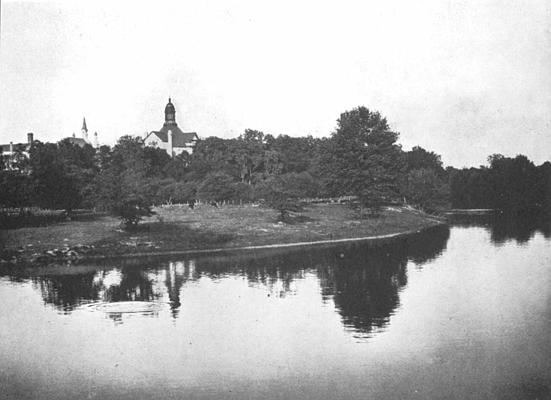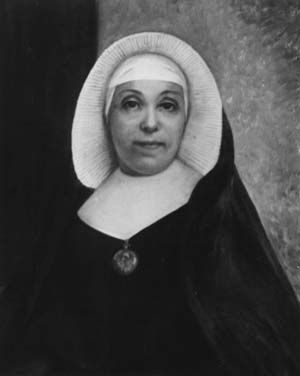
Notre Dame's Grotto / by Dorothy V. Corson


Another Grotto Mystery Solved
Sorin's circular letter contained the only known written reference he ever made to his 1878 Grotto. In it, he seems to stress the point that it was such a neat and exact fac-simile of the real Grotto of Lourdes.
However, there were indirect references to it made by others that seem to suggest that it was not the close replica of the Grotto he had planned to build, which may explain why Sorin's Grotto was also replaced seventeen years later when he was no longer around to object.
There appears to have been a bit of a mystery associated with both the earlier St. Mary's Grotto and the one Father Sorin built in 1878. No one living had ever heard of them and no books written about the campus recorded their existence.
The following excerpts from a variety of sources may explain somewhat this mystery. They also confirm that St. Mary's Grotto was Mother Angela's own inspiration.
An article was written for the Baltimore Catholic Mirror , by the same woman mentioned earlier, Mary Regina Jamison. Coincidentally, she visited both Notre Dame and St. Mary's on August 22, 1878, the day Father Sorin's Grotto was dedicated. That same day she described St. Mary's 1874 Grotto as "nearer the original than any she has seen either in this country or in Europe."
In this second article written at the same time, under the title "An Indiana Academy," Mary Regina Jamison described St. Mary's and made this interesting observation about Grottoes:
To sanctify all these natural enjoyments of the campus, there is a spiritual atmosphere pervading the whole place that would rejoice the heart of Father Faber: plenty of beautiful oratories in the house and about the play-grounds, a Grotto of Lourdes, and a facsimile of the Holy House of Loretto. Although an indoor arrangement, the grotto is the first correct reproduction of the real Grotto of Lourdes that I have seen in America. Many churches and religious houses have so-called grottoes, but they are only handsome oratories , entirely unlike the rocky spot where our Immaculate Mother appeared to Bernadette. . . . At an early date the Mother Superior intends having a grotto in the Academy grounds at a spot on the river bank [in the glen] closely resembling the natural situation of the Grotto of Lourdes . No doubt many devout persons who find it impossible to cross the ocean will then gladly make a pilgrimage to St. Mary's Grotto.(60)
Could viewing Sorin's new octagonal shrine-like Grotto have triggered Miss Jamison's remarks about inaccurate oratories? If she had seen both Grottoes at the same time, and pronounced the earlier St. Mary's Grotto as the closest replica to Lourdes in United States or Europe, what had the rest of Sorin's first Grotto looked like, and why hadn't she mentioned it?
The area allotted for the original 1874 St. Mary's indoor Grotto must have been more than three times the width of the present six by ten foot alcove, now narrowed by two closets placed on each side of it. The Lourdes statues stand alone in the small alcove. They are now silent witnesses to what must have been, from descriptions of it, a warm and appealing depiction of the Our Lady of Lourdes Grotto at St. Mary's.
The river bank in the glen was ideally suited for the outdoor Grotto Mother Angela planned to build. It was very much like the site of the Lourdes Grotto in France. The disappearance of St. Mary's Grotto eight months after Father Sorin's was dedicated -- and the abandonment of Mother Angela's plans to build a grotto in the glen -- seemed to parallel the situation ten years before. The Church name, Our Lady of Sacred Heart, and the funds Mother Angela had already collected for their proposed church, were turned over to Father Sorin to build the new church at Notre Dame in 1869. St. Mary's had to be content with having inaugurated the movement.
 In a letter to Father Sorin, she speaks of her reason for doing so; in order that "a great monument to our Blessed Mother [a new church] can be erected in the United States."
In a letter to Father Sorin, she speaks of her reason for doing so; in order that "a great monument to our Blessed Mother [a new church] can be erected in the United States."
I now feel satisfied," she wrote, "this should be at Notre Dame in preference to Saint Mary's." She concluded: "After a while I am sure (if Providence does not grant other means) that you all at Notre Dame will help to put up a chapel in which we will be able to have Mass the year round."(61)
Perhaps Mother Angela (or Sorin) also felt there was no need for two Grottoes for pilgrimages. Having "satisfied" herself that the Grotto of Our Lady of Lourdes "should also be at Notre Dame in preference to Saint Mary's," she had hers dismantled eight months after Father Sorin built his. Once again, St. Mary's had to be content with having inaugurated a movement -- an Our Lady of Lourdes Grotto for pilgrimages on campus.
An excerpt from Sister M. Georgia Costin's, Priceless Spirit , sheds more light on the subject. She quotes Mother Compassion who, "continues into a matter for which Mother Angela has been both praised and blame:"
Mother Angela regarded Very Rev. Father General [Sorin] as God's representative and obeyed him as such, and taught all her Sisters to do the same. No matter how much it cost her or how different her opinion was, as soon as she learned his will she submitted to it without a murmur . . . .(62)